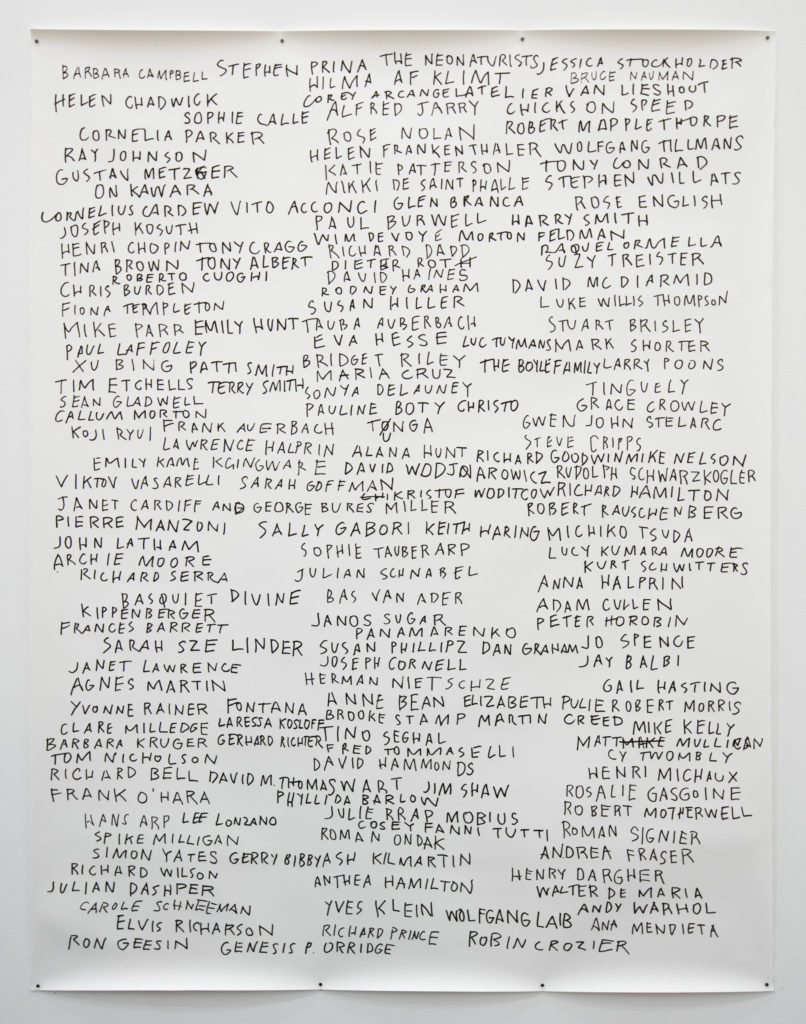The City Gallery remains open under COVID-19 Level 2 alert. The health and safety of our visitors and staff is very important to us so we continue to follow Ministry of Health advice and guidelines around physical distancing, hygiene, visitor numbers and contact tracing. All visitors are asked to stay home if they are feeling unwell, to maintain physical distancing while in the City Gallery and are required to complete contract tracing upon entering via the NZ COVID Tracer app or manually. For more information, please see here.
Art history is too important to be left to art historians. Every Artist is an exhibition of local, national, and international artists who rethink, remap, queer, and even gamify the history of art—often by subverting the tools of art history (maps, charts, diagrams, books, the biopic). This is art history as fodder for art making, not the other way round.
The exhibition springs from Australian artist Agatha Gothe-Snape’s performative project Every Artist Remembered—a collaborative, conversational mapping of an artist-made art history she undertook with invited artists over a decade. The project’s trajectory—from Sydney artist-run-space First Draft in 2009 to London's Frieze Art Fair in 2017—speaks to the visibility and viability of the artists, scenes, and histories it raises.
Italian artists The Cool Couple take these issues to the football field. Their hacked console game turns the beautiful game into a playable history of art—or is it vice versa? Viewers can choose to play as one of twenty art-historical movements (the renaissance, romanticism, post-Internet), featuring over 200 artists (from Tintoretto to Tracey Emin to Simon Denny). Art, like football, is presented as a game to be won or lost—and one always subject to larger forces.
Johnson Witehira and Isiaha Barlow present their own artistic whakapapa (genealogies) in unexpected ways. Witehira’s art-as-arcade-game Maoriland Adventures plays out the politics of Aotearoa’s colonisation by remixing images lifted from the histories of Māori and Pākehā art. Barlow’s paintings of male Māori artists as saints formed a pantheon of contemporary Māori art. Here, the pantheon expands through a lesser-known series celebrating the female saints of Māori art. A painting by one of these figures, Emily Karaka, maps her own sources and inspirations.
Sydney-based New Zealand artist Ella Sutherland’s new body of work considers the impulse of returning to or unlocking official accounts and spaces to let in or restore other trajectories and presences—and applies it specifically to queer art histories.
This shared insistence that artists have the power to construct their own genealogies and rewrite official accounts underpins other works in the exhibition by major international artists. American artist Hank Willis Thomas messes up Alfred H. Barr’s famous Cubism and Abstract Art diagram, which sits at the heart of modern-art history. Thomas exposes modern art’s dependence on and contribution to the colonial project, both built on the exploitation of other cultures and the suppression of their narratives and histories. The montage films of Tracey Moffatt deconstruct Hollywood stereotypes of the artist and the creative act, while Cree artist Kent Monkman takes us into the modern wing of a hospital which cares for broken or forgotten art traditions. Many of these patients are in desperate need of treatment or even resuscitation—procedures that Monkman’s video and this exhibition insist might best be performed by other artists.
Every Artist includes works by Isiaha Barlow (NZ), The Cool Couple (ITA), Matthew Couper (NZ/US), Agatha Gothe-Snape (AUS), Julia Holden (NZ), Emily Karaka (NZ), Tracey Moffatt (AUS), Kent Monkman (CAN), Ella Sutherland (NZ), Hank Willis Thomas (US), and Johnson Witehira (NZ). Hundreds of others are listed, pictured, invoked, collaborated with, played, or performed.



















































































